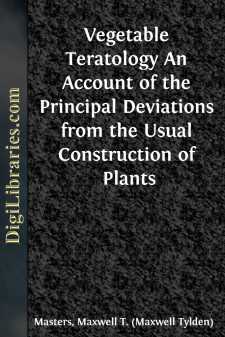Categories
- Antiques & Collectibles 13
- Architecture 36
- Art 48
- Bibles 22
- Biography & Autobiography 813
- Body, Mind & Spirit 142
- Business & Economics 28
- Children's Books 14
- Children's Fiction 11
- Computers 4
- Cooking 94
- Crafts & Hobbies 4
- Drama 346
- Education 46
- Family & Relationships 57
- Fiction 11829
- Games 19
- Gardening 17
- Health & Fitness 34
- History 1377
- House & Home 1
- Humor 147
- Juvenile Fiction 1873
- Juvenile Nonfiction 202
- Language Arts & Disciplines 88
- Law 16
- Literary Collections 686
- Literary Criticism 179
- Mathematics 13
- Medical 41
- Music 40
- Nature 179
- Non-Classifiable 1768
- Performing Arts 7
- Periodicals 1453
- Philosophy 64
- Photography 2
- Poetry 896
- Political Science 203
- Psychology 42
- Reference 154
- Religion 513
- Science 126
- Self-Help 84
- Social Science 81
- Sports & Recreation 34
- Study Aids 3
- Technology & Engineering 59
- Transportation 23
- Travel 463
- True Crime 29
Vegetable Teratology An Account of the Principal Deviations from the Usual Construction of Plants
Categories:
Description:
Excerpt
INTRODUCTION.
Till within a comparatively recent period but little study was given to exceptional formations. They were considered as monsters to be shunned, as lawless deviations from the ordinary rule, unworthy the attention of botanists, or at best as objects of mere curiosity. By those whose notions of structure and conformation did not extend beyond the details necessary to distinguish one species from another, or to describe the salient features of a plant in technical language; whose acquaintance with botanical science might almost be said to consist in the conventional application of a number of arbitrary terms, or in the recollection of a number of names, teratology was regarded as a chaos whose meaningless confusion it were vain to attempt to render intelligible,—as a barren field not worth the labour of tillage.
The older botanists, it is true, often made them the basis of satirical allusions to the political or religious questions of the day, especially about the time of the Reformation, and the artists drew largely upon their polemical sympathies in their representations of these anomalies. Linnæus treated of them to some extent in his 'Philosophia,' but it is mainly to Angustin Pyramus De Candolle that the credit is due of calling attention to the importance of vegetable teratology. This great botanist, not only indirectly, but from his personal research into the nature of monstrosities, did more than any of his predecessors to rescue them from the utter disregard, or at best the contemptuous indifference, of the majority of botanists. De Candolle gave a special impetus to morphology in general by giving in his adhesion to the morphological hypotheses of Goethe. These were no mere figments of the poet's imagination, as they were to a large extent based on the actual investigation of normal and abnormal organisation by Goethe both alone, and also in conjunction with Batsch and Jaeger.
De Candolle's example was contagious. Scarcely a botanist of any eminence since his time but has contributed his quota to the records of vegetable teratology, in proof of which the names of Humboldt, Robert Brown, the De Jussieus, the Saint Hilaires, of Moquin-Tandon, of Lindley, and many others, not to mention botanists still living, may be cited. To students and amateurs the subject seems always to have presented special attractions, probably from the singularity of the appearances presented, and from the fact that in many cases the examination of individual instances of malformation can be carried on, to a large extent, without the lengthened or continuous investigation and critical comparative study required by other departments of botanical science. Be this as it may, teratology owes a very large number of its records to this class of observers.
While the number of scattered papers on vegetable teratology in various European languages is so great as to preclude the possibility of collating them all, there is no general treatise on the subject in the English language, with the exception of Hopkirk's 'Flora Anomala,' a book now rarely met with, and withal very imperfect; and this notwithstanding that Robert Brown early lent his sanction to the doctrines of Goethe, and himself illustrated them by teratological observations. In France, besides important papers of Turpin, Geoffroy de Saint Hilaire, Brongniart, Kirschleger and others, to which frequent allusion is made in the following pages, there is the classic work of Moquin-Tandon, which was translated into German by Schauer. Germany has also given us the monographs of Batsch, Jæger, Rœper, Engelmann, Schimper, Braun, Fleischer, Wigand, and many others. Switzerland has furnished the treatises of the De Candolles, and of Cramer; Belgium, those of Morren, &c., all of which, as well as many others that might be mentioned, are, with the exception of Moquin-Tandon's 'Eléments,' to be considered as referring to limited portions only and not to the whole subject.
In the compilation of the present volume great use has been made of the facts recorded in the works just cited, and especially in those of Moquin-Tandon, Engelmann, and Morren. A very large number of communications on teratological subjects in the various European scientific publications have also been laid under contribution. In most cases reference has been given to, and due acknowledgment made of, the sources whence information has been gathered....


